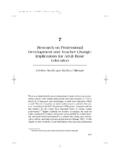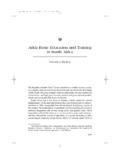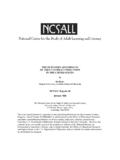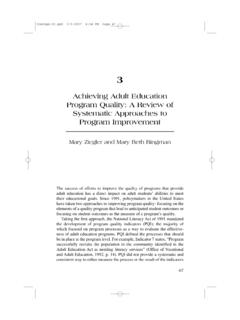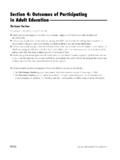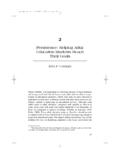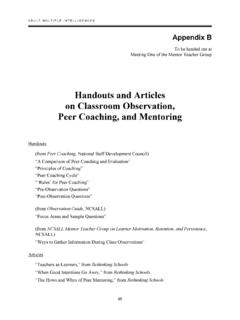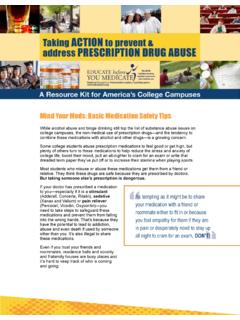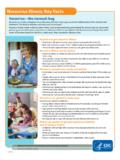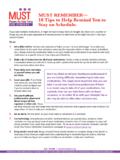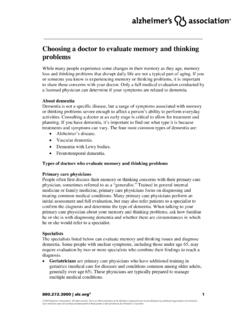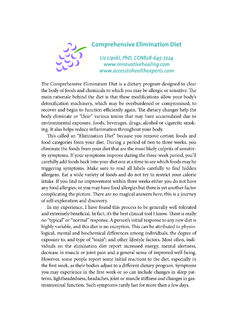Transcription of Lesson 7: (ESOL) Talking About Symptoms to Your …
1 Lesson 7: (ESOL) Talking About Symptoms to your Doctor Page 1 of 14 Lesson 7: (ESOL) Talking About Symptoms to your Doctor Disease Prevention and Screening Task Addressed in this Lesson Describe Symptoms clearly and accurately to a doctor Skills Focus Students will learn language expressions and adjectives for Talking About Symptoms . Students will develop communication strategies that can help them be as specific as possible About the nature of Symptoms and the conditions under which Symptoms appear. ABE/ESOL Level Intermediate to advanced ESOL Time 2 hours Materials Student Handouts Key Vocabulary ache constant crusty dull exhaustion frequent itchy inflammation irritation low energy mild moderate occasional oozing severe sharp soreness spotty throbbing tiredness twinge Purpose This Lesson is designed to help students learn how to describe their Symptoms clearly and effectively.
2 This Lesson begins by inviting the students to discuss how Talking to a doctor About a health concern is a lot like Talking to a car mechanic About a problem with their car. This analogy provides a framework for helping students understand the value of being clear and specific. Students practice using details About Symptoms , including their character, duration, onset, and conditions. A chart of vocabulary words used to describe Symptoms is provided. Steps 1. Whole class discussion. Distribute the handouts. Ask students to look at the page titled Talking About Symptoms to your Doctor. Discuss the question How is Talking to a car mechanic when you have a problem with your car a lot like Talking to a doctor when you have a health problem?
3 Give students a few minutes to write down their thoughts. Then ask students to share what they ve written with the whole class. (See possible responses below.) Material in this Lesson is adapted from lessons in English Vocabulary in Use (Michael McCarthy and Felicity O Dell, 1994, Cambridge University Press) and information published by the American Automobile Association (AAA) Web site, Communicating with Service Professionals at HALL/NCSALL Health Literacy Study Circles+ Skills for Disease Prevention and Screening Lesson 7: (ESOL) Talking About Symptoms to your Doctor Page 2 of 14 It s hard to know what s wrong with a car and what s wrong with our bodies sometimes.
4 We have to explain a lot of things to a car mechanic and a doctor to figure out what is wrong. Sometimes the car mechanic doesn t understand what the problem is with the car. Sometimes the doctor also doesn t understand what the problem is with our body. Car mechanics and doctors both ask lots of questions. It can be hard to find words to describe noises and feelings or sensations. After students have had an opportunity share some of their ideas, explain that the topic of the day s Lesson is how to talk to your doctor About your Symptoms . Write the word symptom on the board and ask students to help you define the word. Encourage them to use their dictionaries and to translate the word into their first language.
5 Here is a suggested definition: It s useful to think of Symptoms as what the patient feels and signs as what the doctor observes. Symptoms , like tiredness (fatigue) and pain, are subjective experiences. (In contrast, signs, like abnormal pulse rate or high blood pressure, are objective features of an illness that can be detected by the doctor during a physical examination.) The doctor cannot easily measure or observe Symptoms . Only the patient knows exactly what his or her Symptoms feel like. doctors try to understand the nature and pattern of a patient s Symptoms in order to make a diagnosis. 2. Small group work: Reading and discussion. Organize the class into small groups of three to four people.
6 Ask the groups to read the handout titled Signs from your Car, Signs from your Body. Explain that the reading talks more About the similarity between Talking to your car mechanic and Talking to your doctor. After the group reads the paragraph, they should answer the discussion questions from the handout. Encourage the students to use their dictionaries or ask for help with unfamiliar vocabulary. Record any new words and their meanings on the board for all to see. Check in with each group to make sure they do not have trouble understanding the ideas in the handout. 3. Large group discussion: What does it mean to be CLEAR and SPECIFIC? Invite the groups to share their responses to the discussion questions.
7 Be sure to check the students understanding of what it means to be CLEAR and SPECIFIC when describing your Symptoms to a doctor. The more information you give to a doctor, the more likely the doctor will be able to identify the problem. HALL/NCSALL Health Literacy Study Circles+ Skills for Disease Prevention and Screening Lesson 7: (ESOL) Talking About Symptoms to your Doctor Page 3 of 14 Be sure to recognize the students worries and concerns About Talking to a doctor About their Symptoms . It is easy to be scared and nervous when Talking to a doctor About your health, especially when you don t feel very well. At the same time, if you are too scared or nervous, you may not be able to think clearly, describe your Symptoms effectively, or ask good questions.
8 Not all doctors are good listeners. Students will need help as they think About what to say to a doctor. They need practice asking questions and planning skills to decide what to focus on. Many people are assertive in this way when they talk to a car mechanic because they want their car fixed quickly and in the right way. This is a useful way of thinking About Talking to doctors to avoid delays in getting health care. 4. Small group work: Practice describing Symptoms . Ask students to turn to the handout Practice: How to Describe your Symptoms , which features several questions that can help the students know what to say to the doctor About Symptoms .
9 Ask the students to work in their small groups to read the questions and the examples of things to say to a doctor. Ask the students to practice what they might say to a doctor. Also, refer students to the handout Vocabulary for Describing Symptoms , which gives examples of words used to describe pain, tiredness, and rashes. Encourage the students to use the words from this handout in their descriptions. Encourage students to add other Symptoms ( , fever, stress) and add other related nouns, verbs, and adjectives to the list. The follow-up activities in this Lesson describe ways to use this handout for vocabulary development. Follow-up Activities A.
10 Vocabulary for Describing Symptoms Ask students to review the vocabulary in the handout Vocabulary for Describing Symptoms , and to use a dictionary to learn the meanings of any new words. Students can work in pairs to explore the differences in meaning for a group of words related to a particular symptom . Students can discuss, for example, how a dull pain feels different from a sharp pain, or how a twinge is different from a throbbing pain. Encourage students to come up with strategies for remembering these differences, such as ordering these words on a continuum to indicate severity of pain. For example, students might generate mnemonics such as this: 0 5 10no pain mild dull moderate throbbing severe Students can also work in pairs to generate descriptive words for other Symptoms , such as shortness of breath, fever, stress, or anxiety.
